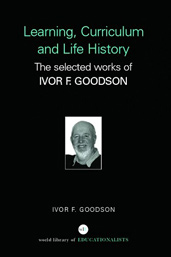Learning, Curriculum and Life Politics: the selected works of Ivor F. Goodson
Nations at Risk
Behind the myths projected by the current UK government and echoed by some of the more sympathetic newspapers and media, the UK economy remains under-capitalized and in many instances, hopelessly uncompetitive. So much for the economic basis of the 'nation at risk'. But perhaps even more significant are the tendencies towards globalization of economic and social life. In the UK case this is rendered particularly acute by the impending full-scale integration into the European Community. Symbolically the Channel Tunnel will connect UK life with that in Europe. The 'island nation' will quite literally be opened up to subterranean entry. The fear of the nation being at risk no doubt explains the hysteria behind so much of the Thatcher government's response to European integration.[i] Pervasive in this response is the sense of a loss of control, a loss of national destiny and identity. The school curriculum provides one arena for reasserting control and for re-establishing national identity.
The move towards a national curriculum in the UK can be traced back to the late 1970s. The key date in UK post-war educational history was Prime Minister James Callaghan's Ruskin College [Oxford] Speech in 1976. Here economic decline and an accelerating sense of national demise (the UK had joined the EEC in 1973) were attached to the decline in educational standards which it was argued had been fostered in comprehensive schools by the use of more 'progressive' methods. Callaghan's speech called for a 'Great Debate' on the UK's educational policies. Following this initiative, in 1977, a Green Paper, Education in Schools: A Consultative Document, was issued. The arguments for a common 'core' or a 'protected' element emerged. The principal points of concern appear to be:
- (i) the curriculum has become overcrowded; the timetable is overloaded, and the essentials are at risk;
- (ii) variations in the approach to the curriculum in different schools can penalize a child simply because he or she has moved from one area to another;
- (iii) even if the child does not move, variations from school to school may give rise to inequality of opportunities;
- (iv) the curriculum in many schools is not sufficiently matched to life in a modern industrial society.
Not all these comments may be equally valid, but it is clear that the time has come to try to establish generally accepted principles for the composition of the secondary curriculum for all pupils. This does not presuppose uniform answers: schools, pupils, and their teachers are different, and the curriculum should be flexible enough to reflect these differences. But there is a need to investigate the part which might be played by a 'protected' or 'core' element of the curriculum common to all schools. There are various ways this may be defined. Properly worked out, it can offer reassurances to employers, parents, and the teachers themselves, as well as a very real equality of opportunity for pupils (Fowler, 1988).
[i] This section was written before the withdrawal of the UK pound from the European Exchange Rate mechanism and the effective devaluation of the pound and of course before the replacement of Thatcher by Major.
4. See Goodson, I.F. (1988) and (1993). North American readers unfamiliar with the shorthand way in which I have dealt with issues of social structure may need to refer to these books to examine the argument in greater detail.
